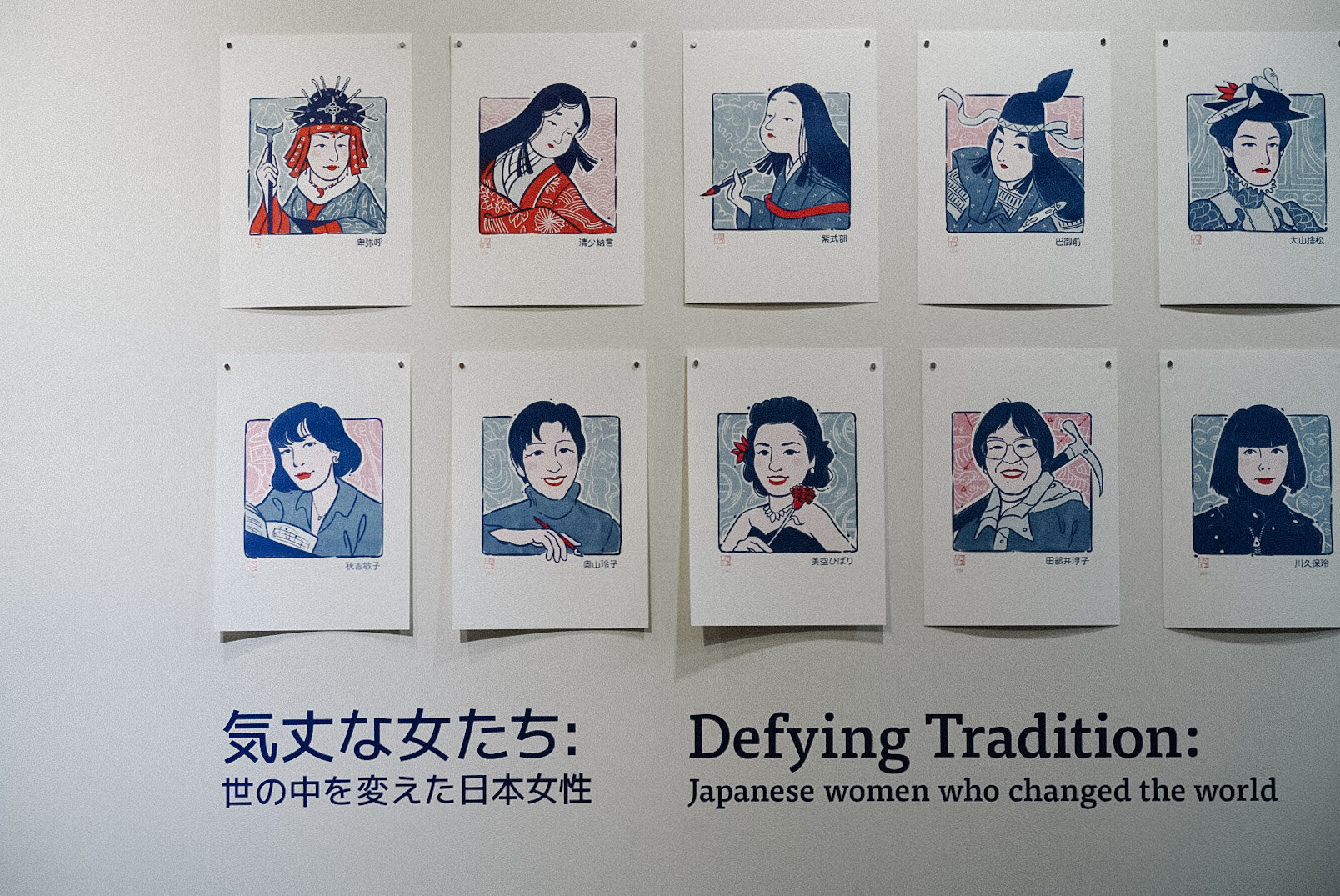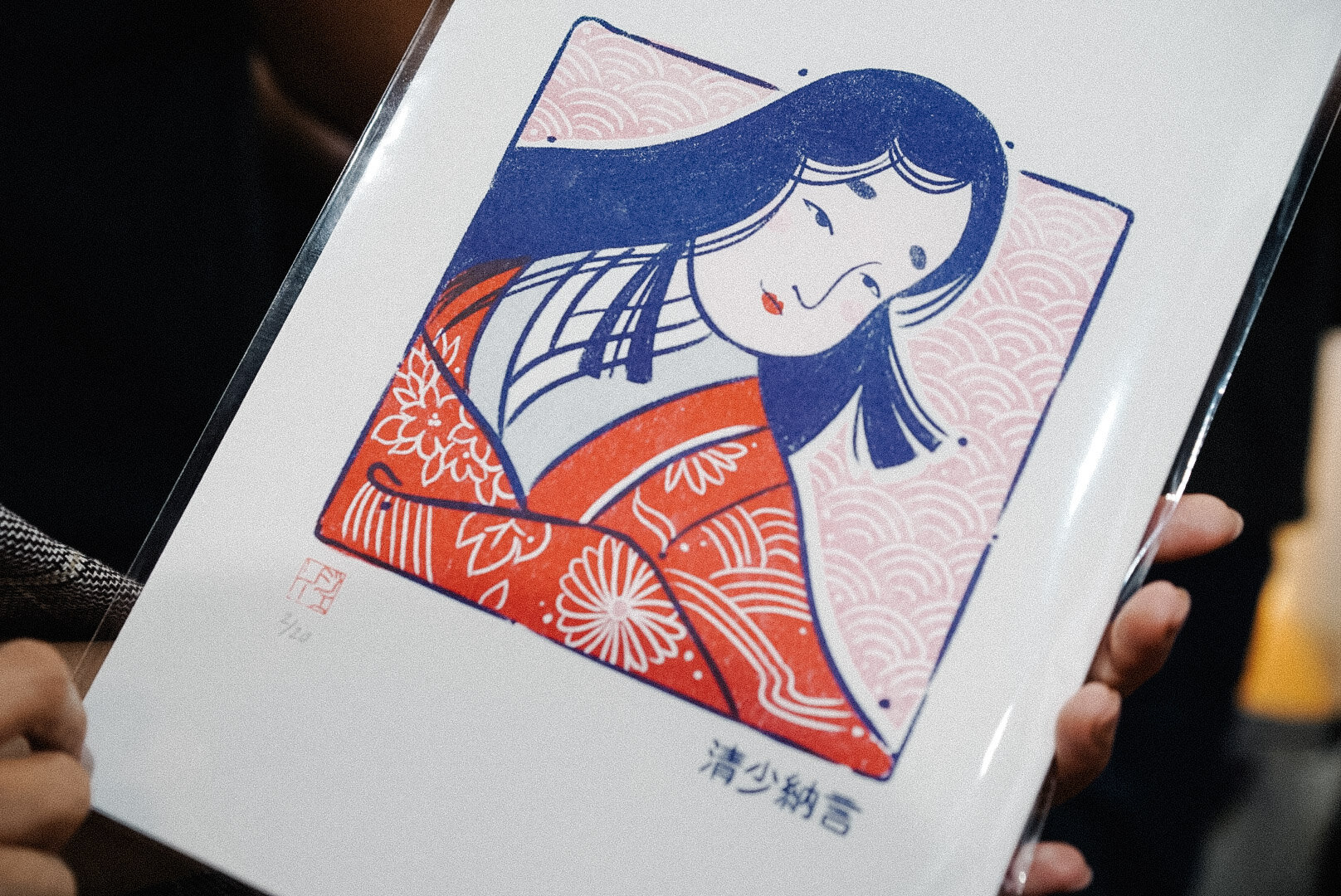 Image 1 of 5
Image 1 of 5

 Image 2 of 5
Image 2 of 5

 Image 3 of 5
Image 3 of 5

 Image 4 of 5
Image 4 of 5

 Image 5 of 5
Image 5 of 5






Hasegawa Machiko 長谷川町子 - A4 Riso Print (Signed and Numbered)
Hasegawa Machiko 長谷川町子
The ‘Grandmother of Manga'
日本初の女性プロ漫画家 (1920年1月30日–1992年5月27日)
サザエさんは、伝統的な性別的役割への期待と「女らしい」ということと戦っていた自由な女性として描かれています。
Hasegawa Machiko was born in 1920 in Taku, Kyushu. When she was 15, her family moved to Tokyo, where she took an interest in drawing manga cartoons. Her first comics, Tanuki no Omen (Badger Mask) appeared in a girls’ magazine in 1938.
Despite being an overall lighthearted manga, Hasegawa’s most famous character, Sazae-san, portrayed a liberated woman who dealt with the life-long struggle of being “lady-like” and the roles of women in society. The character often questioned the view that a man should be the head of a household, and challenged the ideas of what women were expected to wear. Today, many Japanese look back at Sazae-san with fond memories of a time before technology, despite the controversy around its leftist and feminist leanings when it originally ran. Sazae-san ran daily in the Asahi Shimbun from 1949 until 1974 when she retired.
Despite writing about the life of a fictional Japanese housewife, Hasegawa never married, but instead lived with her older sister where they collected artwork together. They went on to start the Shimaisha Publishing Company which published 20 million paperback copies of her comics.
In 1992 she received the People’s Honor Award bestowed by the Prime Minister of Japan for her contributions to enriching a postwar society through lighthearted entertainment. She is often referred to as the “Grandmother of Manga”—a counterpart to the more-often referenced Tezuka Osamu. A TV adaptation of Sazae-san is still running today and holds the Guinness World Record for longest-running animated TV series, surpassing The Simpsons.
What is a riso print?
These prints use risograph technology, a method of printing developed in Japan in the mid-1980s. It can be described as a mix between screenprinting and photocopying. The risograph process produces prints with extremely vibrant, crisp inks, and sometimes these inks overlap during the printing process to create interesting and unique details. These soy-based inks also have a lower environmental impact.
Product details
Printed in Tokyo, Japan by Hand Saw Press print studio. Each print is A4 size (210 x 297 mm / 8.27 x 11.69 in) and printed on Natural White 186gsm Takeo Araveal paper. Acid-free and FSC Approved.
Each print is signed with a traditional Japanese ‘hanko’ artist stamp and hand-numbered from a limited edition of 20. Prints are packaged in cello bags with rigid cardboard inserts and shipped in flat mailers.
Please note that frames are not included.
Delivery times & prices
We ship worldwide. 日本へ国際郵便で送ります。
UK deliveries: 3-4 working days via Royal Mail 1st class
International deliveries available via Royal Mail International Standard Airmail
Prices calculated during checkout
For more information on shipping times for international deliveries, please check the delivery & returns page.
Hasegawa Machiko 長谷川町子
The ‘Grandmother of Manga'
日本初の女性プロ漫画家 (1920年1月30日–1992年5月27日)
サザエさんは、伝統的な性別的役割への期待と「女らしい」ということと戦っていた自由な女性として描かれています。
Hasegawa Machiko was born in 1920 in Taku, Kyushu. When she was 15, her family moved to Tokyo, where she took an interest in drawing manga cartoons. Her first comics, Tanuki no Omen (Badger Mask) appeared in a girls’ magazine in 1938.
Despite being an overall lighthearted manga, Hasegawa’s most famous character, Sazae-san, portrayed a liberated woman who dealt with the life-long struggle of being “lady-like” and the roles of women in society. The character often questioned the view that a man should be the head of a household, and challenged the ideas of what women were expected to wear. Today, many Japanese look back at Sazae-san with fond memories of a time before technology, despite the controversy around its leftist and feminist leanings when it originally ran. Sazae-san ran daily in the Asahi Shimbun from 1949 until 1974 when she retired.
Despite writing about the life of a fictional Japanese housewife, Hasegawa never married, but instead lived with her older sister where they collected artwork together. They went on to start the Shimaisha Publishing Company which published 20 million paperback copies of her comics.
In 1992 she received the People’s Honor Award bestowed by the Prime Minister of Japan for her contributions to enriching a postwar society through lighthearted entertainment. She is often referred to as the “Grandmother of Manga”—a counterpart to the more-often referenced Tezuka Osamu. A TV adaptation of Sazae-san is still running today and holds the Guinness World Record for longest-running animated TV series, surpassing The Simpsons.
What is a riso print?
These prints use risograph technology, a method of printing developed in Japan in the mid-1980s. It can be described as a mix between screenprinting and photocopying. The risograph process produces prints with extremely vibrant, crisp inks, and sometimes these inks overlap during the printing process to create interesting and unique details. These soy-based inks also have a lower environmental impact.
Product details
Printed in Tokyo, Japan by Hand Saw Press print studio. Each print is A4 size (210 x 297 mm / 8.27 x 11.69 in) and printed on Natural White 186gsm Takeo Araveal paper. Acid-free and FSC Approved.
Each print is signed with a traditional Japanese ‘hanko’ artist stamp and hand-numbered from a limited edition of 20. Prints are packaged in cello bags with rigid cardboard inserts and shipped in flat mailers.
Please note that frames are not included.
Delivery times & prices
We ship worldwide. 日本へ国際郵便で送ります。
UK deliveries: 3-4 working days via Royal Mail 1st class
International deliveries available via Royal Mail International Standard Airmail
Prices calculated during checkout
For more information on shipping times for international deliveries, please check the delivery & returns page.
Hasegawa Machiko 長谷川町子
The ‘Grandmother of Manga'
日本初の女性プロ漫画家 (1920年1月30日–1992年5月27日)
サザエさんは、伝統的な性別的役割への期待と「女らしい」ということと戦っていた自由な女性として描かれています。
Hasegawa Machiko was born in 1920 in Taku, Kyushu. When she was 15, her family moved to Tokyo, where she took an interest in drawing manga cartoons. Her first comics, Tanuki no Omen (Badger Mask) appeared in a girls’ magazine in 1938.
Despite being an overall lighthearted manga, Hasegawa’s most famous character, Sazae-san, portrayed a liberated woman who dealt with the life-long struggle of being “lady-like” and the roles of women in society. The character often questioned the view that a man should be the head of a household, and challenged the ideas of what women were expected to wear. Today, many Japanese look back at Sazae-san with fond memories of a time before technology, despite the controversy around its leftist and feminist leanings when it originally ran. Sazae-san ran daily in the Asahi Shimbun from 1949 until 1974 when she retired.
Despite writing about the life of a fictional Japanese housewife, Hasegawa never married, but instead lived with her older sister where they collected artwork together. They went on to start the Shimaisha Publishing Company which published 20 million paperback copies of her comics.
In 1992 she received the People’s Honor Award bestowed by the Prime Minister of Japan for her contributions to enriching a postwar society through lighthearted entertainment. She is often referred to as the “Grandmother of Manga”—a counterpart to the more-often referenced Tezuka Osamu. A TV adaptation of Sazae-san is still running today and holds the Guinness World Record for longest-running animated TV series, surpassing The Simpsons.
What is a riso print?
These prints use risograph technology, a method of printing developed in Japan in the mid-1980s. It can be described as a mix between screenprinting and photocopying. The risograph process produces prints with extremely vibrant, crisp inks, and sometimes these inks overlap during the printing process to create interesting and unique details. These soy-based inks also have a lower environmental impact.
Product details
Printed in Tokyo, Japan by Hand Saw Press print studio. Each print is A4 size (210 x 297 mm / 8.27 x 11.69 in) and printed on Natural White 186gsm Takeo Araveal paper. Acid-free and FSC Approved.
Each print is signed with a traditional Japanese ‘hanko’ artist stamp and hand-numbered from a limited edition of 20. Prints are packaged in cello bags with rigid cardboard inserts and shipped in flat mailers.
Please note that frames are not included.
Delivery times & prices
We ship worldwide. 日本へ国際郵便で送ります。
UK deliveries: 3-4 working days via Royal Mail 1st class
International deliveries available via Royal Mail International Standard Airmail
Prices calculated during checkout
For more information on shipping times for international deliveries, please check the delivery & returns page.





